2023 Sprinter vs. 2023 Transit Trail – How I Chose
I recently made the long-time-coming decision to purchase a van to convert. The first step of the process, deciding which van to get, proved to be more complicated than I anticipated.
Ford recently announced the 2023 Transit Trail – a Transit package with standard all-wheel drive, a 3.5 in / 8.89 cm higher ride than previous Transits, all-terrain tires, and an optional factory-installed roof fan. It’s a van specifically targeting the outdoor recreation market and buyers wishing to convert their vans.
Meanwhile, Mercedes-Benz has released the 2023 Sprinter which features a new all-wheel-drive (AWD) system, a new turbocharged 2.0-liter inline-four diesel engine with a nine-speed automatic transmission, and superior off-road capabilities to previous Sprinter models (thanks to the new AWD system).
The Ram Promaster is the third and final vehicle that’s commonly considered for a van conversion. However, I did not consider the Promaster because it is front-wheel drive only.
It was the announcement of the Transit Trail that set me off on this pursuit, but it was a Sprinter that I ultimately ended up with. Here’s how it happened.
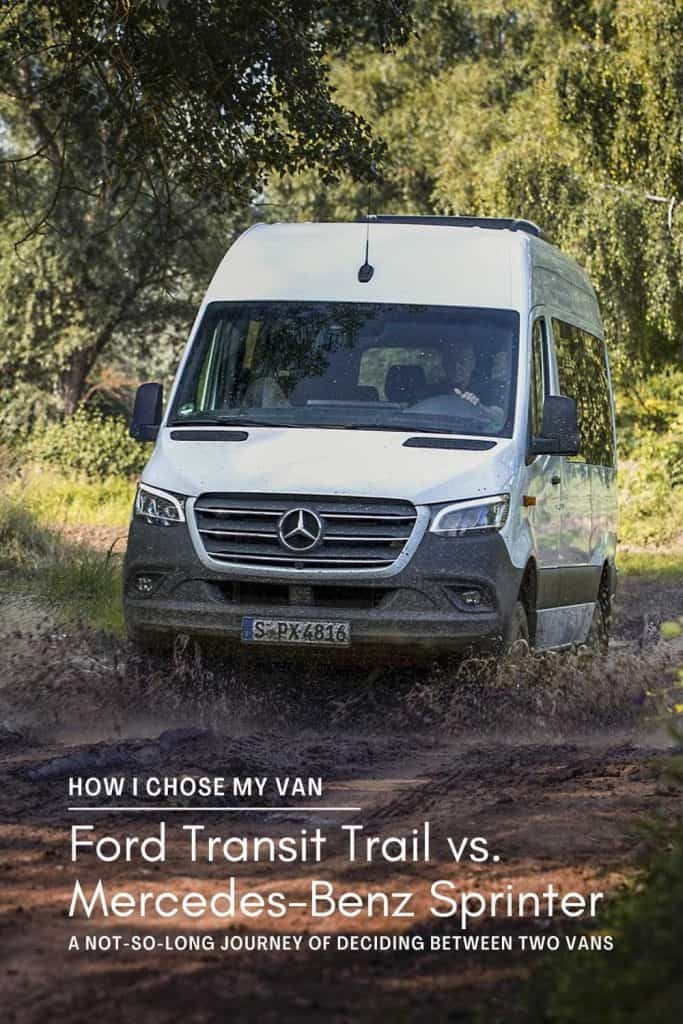
Ford Transit Trail
It is the Ford Transit Trail that initially piques my interest (again) in pursuing a van build.
The new Transit build looks awesome. However, I quickly discover that at the time of my search (the end of 2022), it is incredibly difficult to secure a Transit Trail.
In a strange move, Ford announced the Transit Trail just before they closed the vehicle order banks for the year. This means the only way to get a Transit Trail is to find a Ford dealer with a Transit on order that has the wheelbase and engine required for a Transit Trail build. The Trail package can then be added to this order – so long as it is early enough along in the build process.
I call every Ford dealership in California with no luck. Frustratingly, the Transit Trail is so new that many of the dealers don’t even know what I was talking about when I ask after the build. It is a frustrating experience.
After all this time researching and pursuing a Transit Trail, I am stoked on getting a van. I move on to the next logical thing – telling myself I will just look – and decide to check out the 2023 Mercedes-Benz Sprinter van.
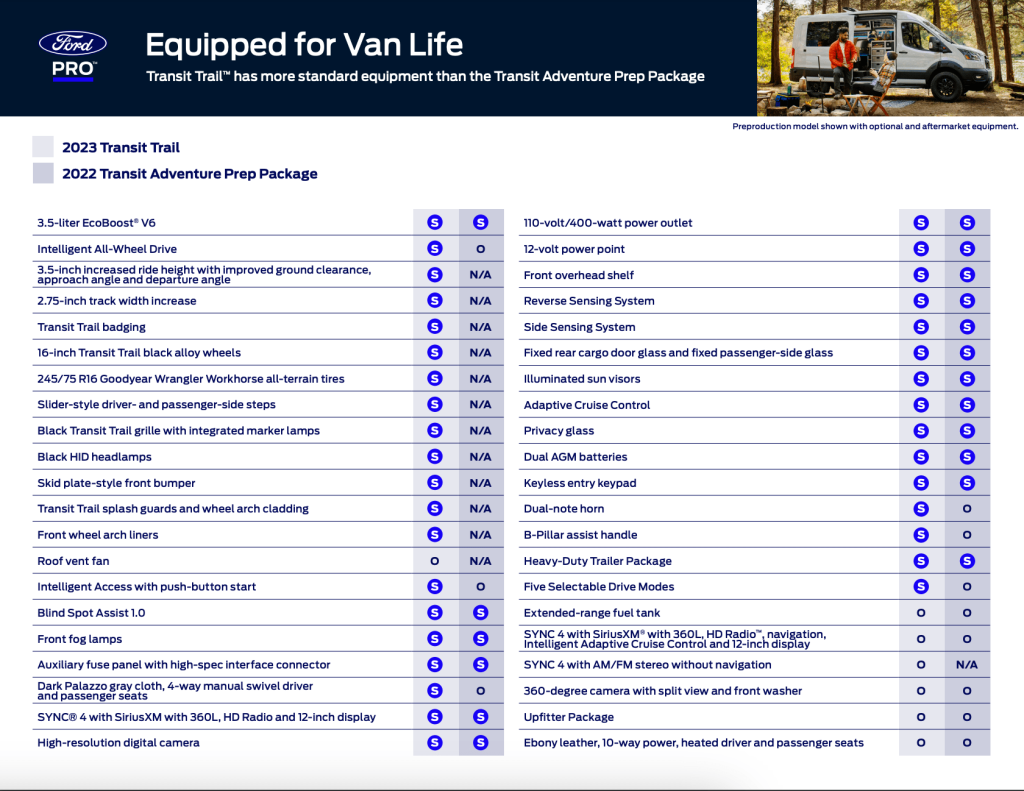
Mercedes-Benz Sprinter
Many people regard Sprinters as the gold standard for conversion vans; I count myself among said people.
When I began my van hunt, the Transit seemed an attractive option because it’s typically considered to be a more affordable alternative to the Sprinter. I tell myself, “I’ll just look at the Sprinters” since I am already excited about vans after diving to the bottom of the Ford Transit Trail rabbit hole.
After configuring a new 2023 Sprinter with all the features I would like, the sticker price ends up around $75,000. The Sprinter’s expensive reputation is not unearned. That said, the base cargo Sprinter starts at $43,500. That said, adding a high roof and all-wheel drive (two must-haves for my van) adds nearly $16,000 to the price – before any additional features.
I begin calling Mercedes-Benz dealerships to inquire about Sprinter availability. After calling every dealership in California, Arizona, Oregon, and Nevada, I discover a few things. For one, not every Mercedes dealership carries Sprinters. More importantly, the 2023 AWD Sprinter availability is in a similar boat to the Transit Trail; Mercedes has closed the order banks for the year, and all the 2023 AWD Sprinters that are going to be made this year have already been made.
That said, I had managed to locate a couple of Sprinters meeting my specs at a handful of dealerships. Dealerships I will spend the next several days trading calls and emails with since they’re all selling their Sprinters above MSRP – by as much as $25,000 over.
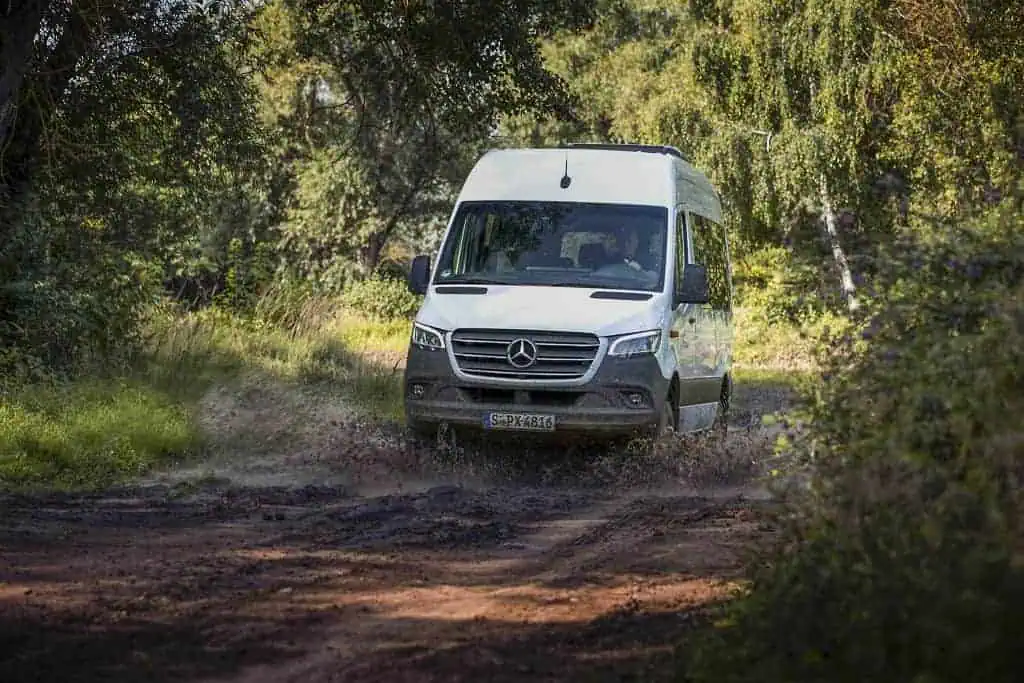
Return of the Transit Trail
I am deep in the Sprinter rabbit hole and have completely written off finding a Ford Transit Trail. Then, I get a call from a committed Ford salesperson who claims to be able to order a Transit Trail.
Previously, this person had been one of the dealers I would have put into the “has no idea what the Transit Trail is” category, but it was clear they had educated themselves. After speaking with them and seeing the build documentation it becomes clear they are telling the truth – there is indeed a way for me to order a 2023 Transit Trail.
There are a few options not standard on the Transit Trail I wanted to add. I request they be added to the build – a 360-degree camera, upgraded entertainment system, and extended fuel tank. When I receive the build sheet I am impressed to see that the Transit Trail I want is able to be ordered; I am surprised to see the price is nearly identical to the Sprinters I am looking at – just over $73,000.
This throws me off because I initially believe the Transit Trail will be the less expensive option. Now facing a near-even cost, I need to take a closer look at the details of both vehicles.
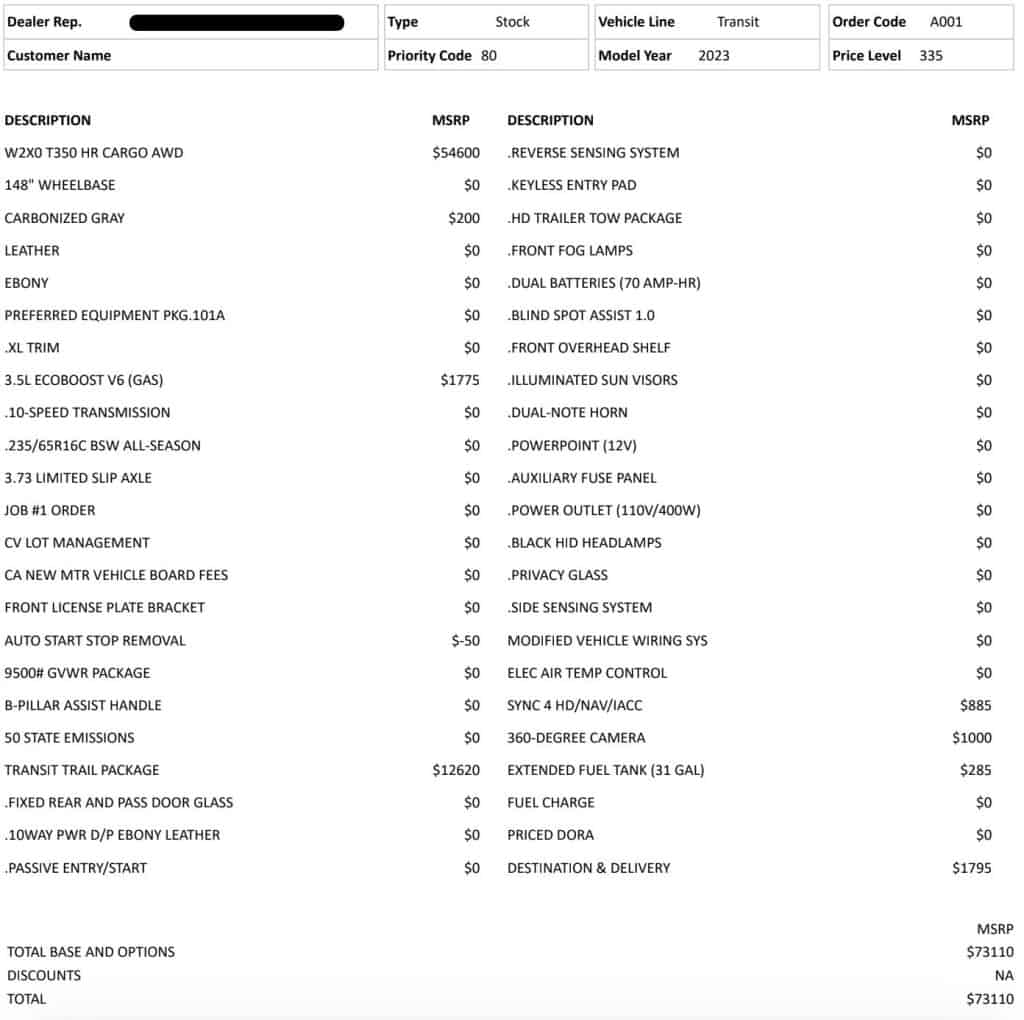
AWD Sprinter vs Transit Trail
I may end up doing an additional post regarding the differences between the 2023 Sprinter and the 2023 Transit Trail, but here I’ll highlight my reasons for ultimately deciding to go with the Sprinter.
2023 Mercedes-Benz Sprinter Pros
- Diesel engines, despite being more costly to maintain (and diesel currently being more expensive than gasoline), are expected to last significantly longer than gasoline engines. Yes, the maintenance may be more expensive, but these costs will never compare to the cost of an entirely new vehicle.
- Sprinters, having been the longtime standard for van conversions, have a ton of aftermarket accessories designed specifically for the Sprinter. Yes, the rising popularity of the Transit has led to more Transit accessories as well, but the Sprinter still has the edge here.
- The Sprinter has the option to include both swivel seats (another must-have for me) that are powered and heated. With the Ford Transit, you need to choose between swivel seats and powered/heated seats.
- Despite the Ford Transit Trail riding 3.5 in / 8.89 cm higher than other/older Transits, the Sprinter still has it beat with 1.3 in / 3.3 cm more clearance than the Transit Trail.
- The Sprinter has three USB-C ports. I love USB-C and can’t wait for all devices and ports to use USB-C instead of the traditional USB ports. Not a huge deal, but something I thought was interesting and worth nothing.
2023 Ford Transit Trail Pros
- The Transit Trail has the option to add an extended-range fuel tank from the factory, 31 gallons vs the Sprinter’s 25-gallon tank.
- There are far more Ford dealerships and mechanics available to work on gasoline-powered Transits than there are Mercedes-Benz dealerships and mechanics available to work on diesel-powered Sprinters.
- Ford offers a 12-inch touchscreen vs. the Mercedes-Benz 10-inch touchscreen available in the Sprinter. The Ford infotainment screen is much sleeker and nicer looking than that available for the Sprinter (at least in my opinion). Both cars are Android Auto and Apple Car Play compatible.
- The Transit offers more headroom in the high-roof version than does the Sprinter high roof. That said, both offer me (5’10” / 179 cm) ample standing room.
Wrap Up
Ultimately, I think both the 2023 Transit Trail and the 2023 AWD Mercedes-Benz Sprinter are great options for van conversions. However, surprised by the near-equal price, I decided to go with the Sprinter because of the diesel engine, additional clearance, and extra options available.
It’s still early in my van journey, but now that I’ve taken the plunge and gotten myself a vehicle the fun part can begin. Building it out is the fun part, right?
Questions? Comments? Suggestions for a build? Leave a comment below and let me know!
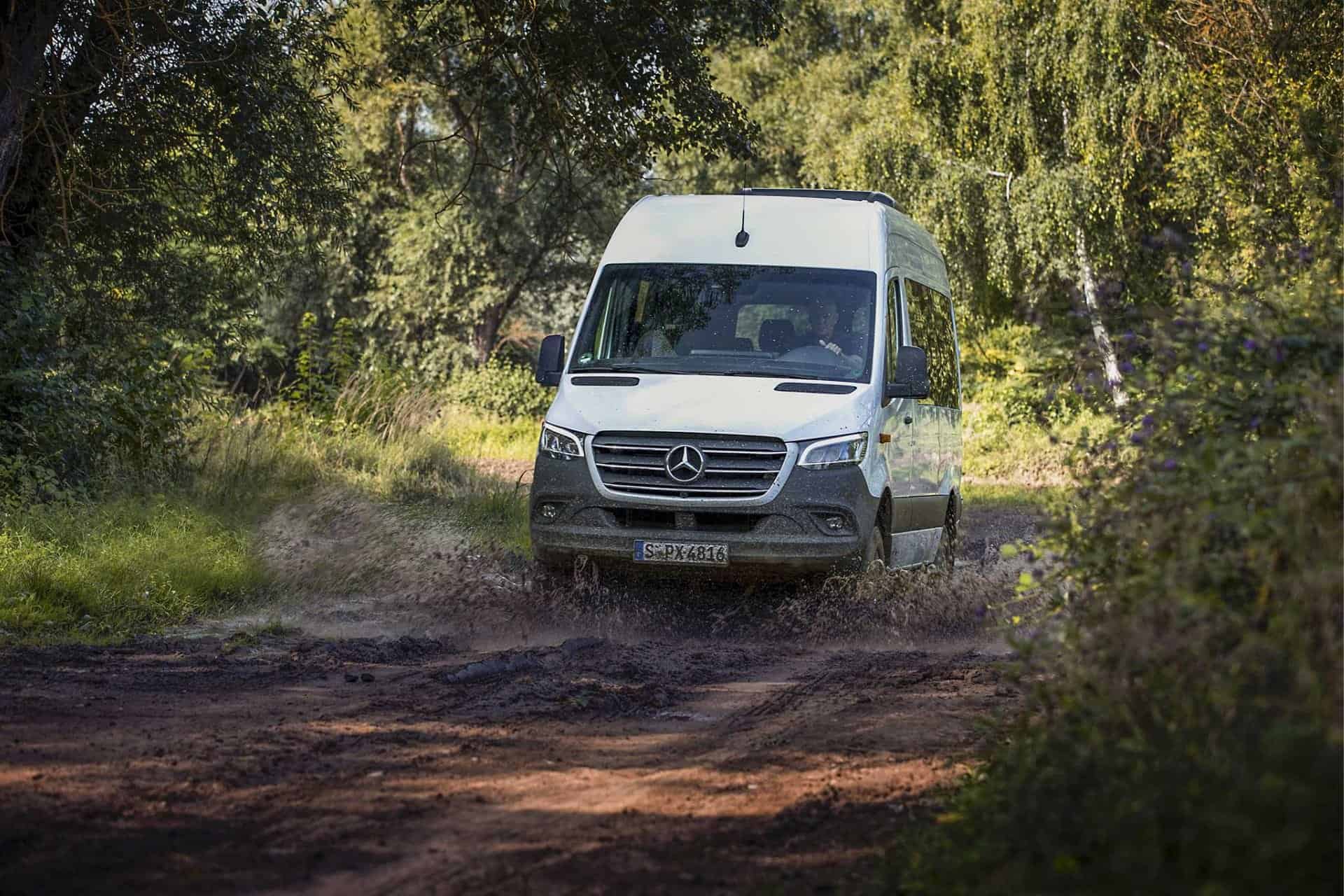
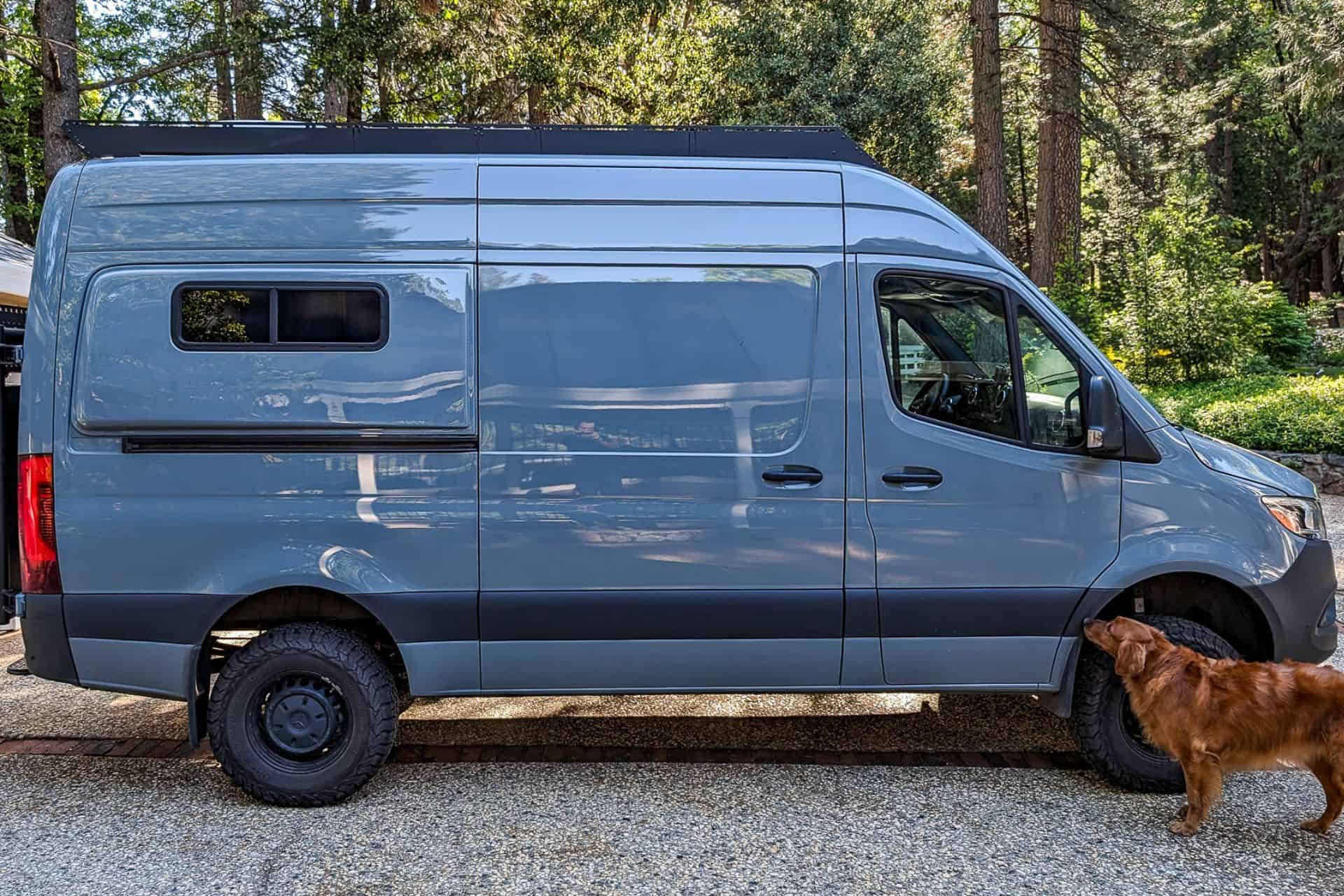
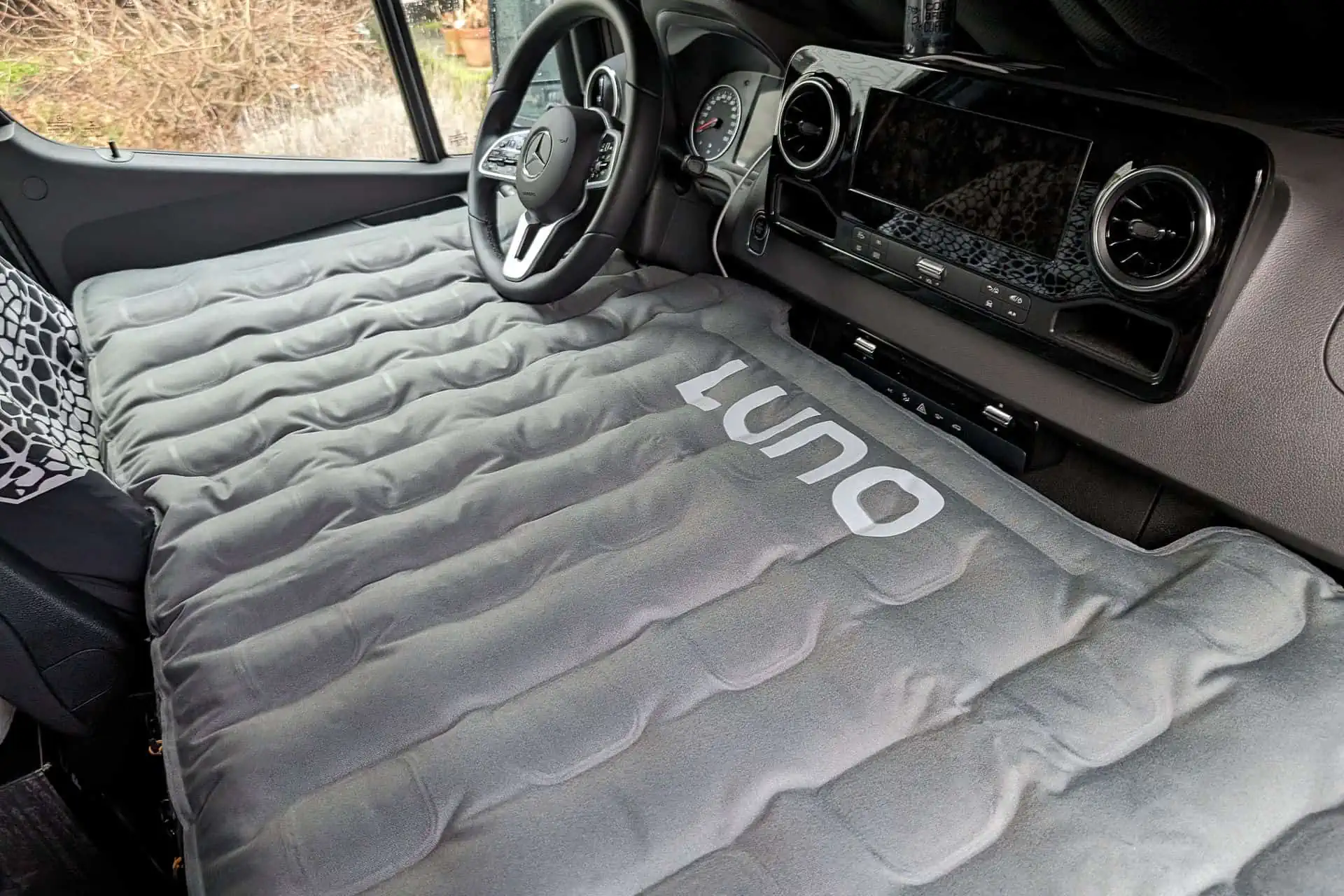



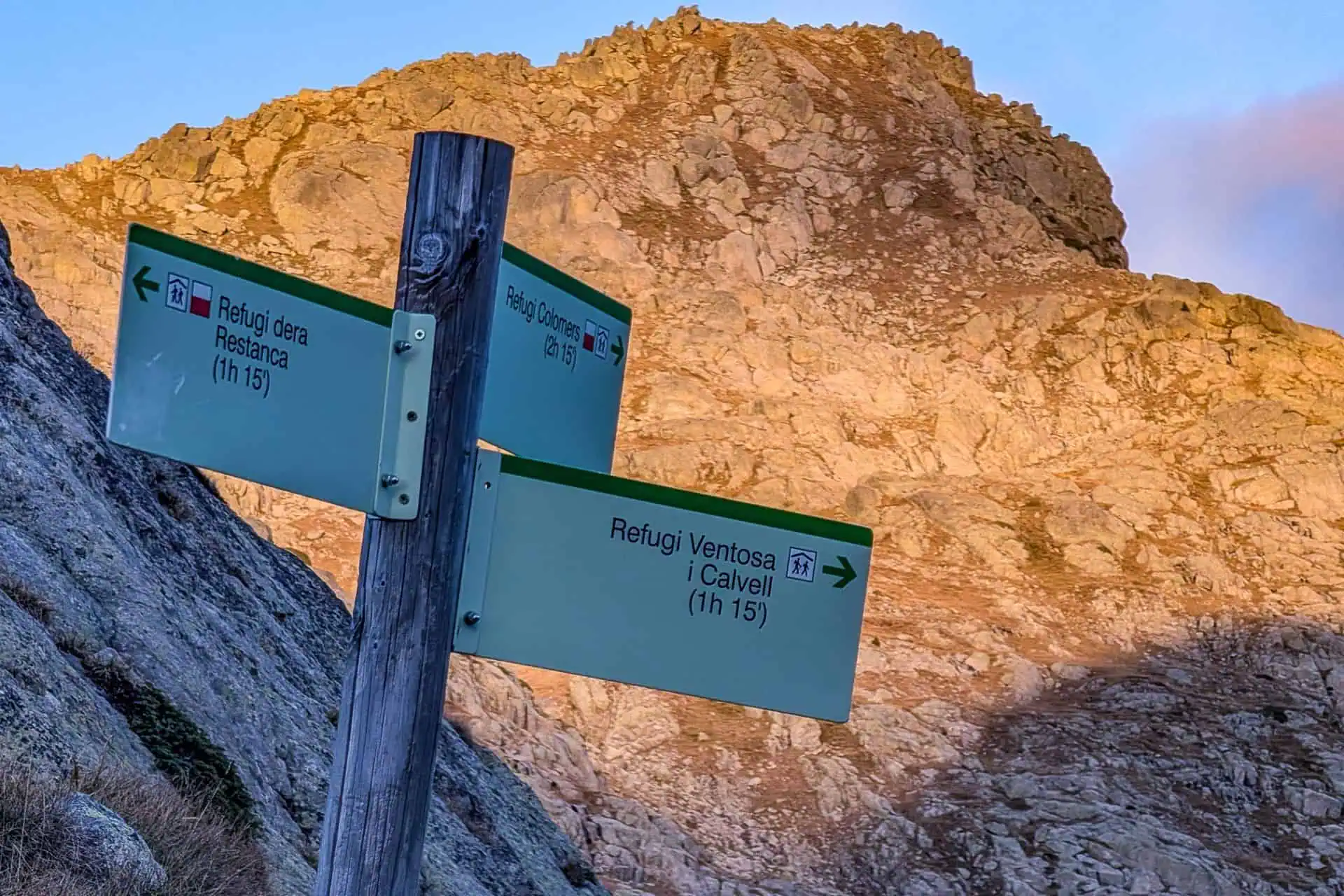
I’m in the same spot as you at the start. Sprinter vs transit trail. This is very helpful. Do you post in Facebook or IG? Would be interested to follow your build.
IG here: https://www.instagram.com/halfwayanywhere/
Not meticulously documenting on IG (will be posting on the website as well), but I will have some content up.
Have you considered the MAN TGE? I am at the moment going through and considering it as an alternative to the transit.
I had never heard of the MAN TGE. Is that available in the US?
You didn’t mention the biggest difference between the van platforms. Mpg.
I admittedly a bit of a 55 mph driver, but still I got 22.7 mpg driving my 7,500 lb build from Denver to Bend through Nevada.
I doubt the Ford would have been over 18.
An excellent point and not one I had much considered! Currently worrying about the amount of weight I’m adding to the build, but I think it will be fine.
Do you have a build sheet for the 2023 sprinter? I am currently looking to purchase a transit trail or sprinter awd.
I do – I will post it here shortly.
Do you happen to have a picture of the build sheet for your sprinter, similar to what you did for the transit? I’m in the process of figuring out what is good to have and what you can pass on for a Sprinter with conversion in mind.
I do – I will post it here shortly.
What about all of the DEF/Emissions issues with Sprinter? Does the new 2.0L 4-cylinder inline engine perform better than the prior years? Seems like complaints continue to be persistent around these emission systems.
It appears that these issues have all been addressed with the newer models.
Thanks. Newer, as in what years? We will be doing a lot of city driving hence more of a concern for us
Afaik newer as in 2023+
I have the Ford Transit 3.2L Diesel and had nothing but problems with the emission/egr system. On the other hand, I have 225k miles and the engine runs perfectly. It is difficult to find diesel mechanics on road trips when the emissions/egr is problematic. The van has gone into limp mode several times due to EGR issues and left us stranded. Beware!
Good thing I went with the Sprinter!
I had an AWD transit before the new one came out and converted it. I had it less than a year and sold it to buy a sprinter. Having driven my parents sprinter on a trip, then my transit, it was very clear the sprinter is a lot more comfortable to drive long distance. I searched high and low for a Sprinter with the options I wanted and came across the same thing with the mark ups. I ended up finding one on the East Coast with no mark up and exactly what I wanted, so when it came in from the factory I flew over and drove it back to North Idaho. Made a trip out of it and saw new things along the way! Then about 6 months later my parents did the same and upgraded theirs! A solid year to build them both out but so worth it in the end!
Nice! I am realizing that the build is going to take quite a bit but I’ve already started sourcing pieces and am excited to get started.
All the stuff behind the walls felt like it took forever to complete. There is a lot to do before you can start really building everything and seeing progress. My dad and I have done 4 build outs now and it’s always a fun puzzle to figure out!
So much wiring…
I think the big difference is that the Fords are available at list and the Mercedes are all going for $25k over list?
That will change with time. If you’re looking for one now I would shop around. I found that 25k was the max over list they were going for. Had many dealerships offer between 1 and 5k over list.
Good choice. I have a Ford F-150 with the engine/transmission package you would have gotten. I have a friend with a Sprinter and his drivetrain is much smoother. Ford’s 400-watt inverter is, at best, a bad joke. You will want at least a 3000-watt inverter to do anything real. My friend is living in his Sprinter. Insulated with an aftermarket diesel heater under the passenger seat. Keeps it nice and toasty in the winter on almost no fuel (something like a gallon/day). He has a huge solar array on the roof and a stack of Li batteries and has plenty of power to do anything. Have fun with the project!
I did consider an F-150+Shell for a while. The diesel heater is something I’ve been scoping out and I’m trying to decide whether I will be able to do the install myself. The same goes for the electrical. It’s definitely going to be a learning experience!
Excited to see how you do it and the end result!
Here’s to hoping it goes well with minimal errors of grave proportions.